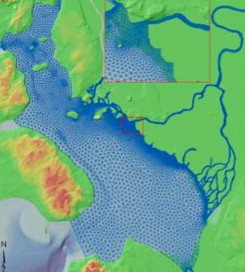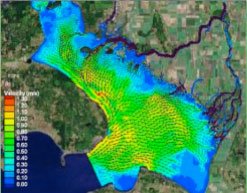Hydrodynamic Modeling of Skagit Bay, for Rawlins Road Restoration Assessment
SRFB Grant through Skagit Watershed Council: $101,000 from 2005 to 2007
Background and motivation: The Skagit River Delta provides rich estuarine and freshwater habitats for salmon and many other species of wildlife. Over the past 150 years, economic development in the Skagit Delta Estuary has resulted in significant losses of wildlife habitat, particularly due to construction of dikes. This has resulted in disconnected and isolated pathways of freshwater and natural sediment to the mudflats and tidal marsh area near the river mouth. The diked portion of the delta is known as Fir Island, which is used for agriculture. Over the last century this area has progressively experienced land subsidence, which combined with the dikes, has caused reduced efficiency of the drainage network and has impeded fish passages through the area.
Objective: The overall objective of this project is to increase productivity of habitat, expand migratory opportunity for salmonids, and restore landscape ecological processes through modifications to dikes and hydraulic and hydrologic features with minimum impact on current land use. The specific task was to evaluate the feasibility of restoring natural tidal functions through modification of the dikes near the Rawlins Road region of the northwest corner of Fir Island.
Pacific Northwest National Labs developed a three-dimensional tidal circulation model for the Skagit River Delta to assess feasibility of estuarine restoration alternatives using the Finite Volume Coastal Ocean Model (FVCOM). The hydrodynamic model was calibrated using field data and applied to simulate different restoration alternatives. The results provided guidance for estuarine restoration and management.
Project Team: Pacific Northwest National Laboratory, Skagit Watershed Council, Seattle City Light, Washington State Department of Fish and Wildlife, and Skagit River System Cooperative.
Project Highlights
- Hydrologic models HEC-HMS UNET were used to simulate drainage inside the diked region of Fir Island and ensure that proposed actions did not adversely affect existing land use or drainage.
- The hydrodynamic model application showed that the restriction caused by dikes along the North Fork of the Skagit River, coupled with a high flow, results in a large fresh water plume with no salt wedge.
- Model results indicated that a diversion to reconnect the North Fork and Skagit Bay through Hall Slough has very good potential to improve the estuarine habitat in the bay-front area by achieving required salinity distribution (reduction in salinity from existing levels).


